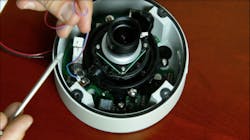Bandwidth and network latency are the most common causes of issues experienced by installers when implementing IP megapixel projects. Calculating bandwidth requirements typically follows coverage and camera placement in the design process.
The manner by which the network is connected is as important as the bitrate of the megapixel cameras and other devices being installed. Care should be taken to reduce load across any one switch to avoid bottlenecks at every uplink point on the network.
It is important to remember that in large video networks, the load aggregates with each hop as you get closer to the server, because more and more streams run parallel to those points.
With network traffic in general:
- Peak performance is maintained at less than or equal to 50 percent of bandwidth capacity;
- Collisions increase at about 50 percent of bandwidth capacity; and
- Packet loss increases at about 80 percent of bandwidth capacity.
The best practice is to design the video network at a 50-percent maximum load. H.264 offers reduction in average bitrate, but it is subject to fluctuation with high activity in the field of view. Planning extra bandwidth overhead can accommodate occasional spikes in bandwidth usage.
Wherever possible, it is advisable to design parallel dedicated video networks. This will simplify implementation and reduce troubleshooting challenges.
Allowing for extra bandwidth capacity will also help to avoid potential difficulties with the IT team by eliminating the need to reconfigure or troubleshoot the network to accommodate the high bitrate loads video traffic may impose.
Two fundamental steps can be taken to alleviate these problems:
- Make sure all cables and connections are certified before plugging in and powering devices; and
- Consult with the camera and VMS manufacturers when selecting network hardware.
It is also advisable to verify standards specifications for twisted pair and termination as determined by the Electronic Industries Alliance (www.ecaus.org) and the Telecommunications Industry Association (www.tiaonline.org). You should always follow the wiring standards set by these organizations.
More High-Res Video Installation Best Practices
Here are six more essential best practices for high-resolution video surveillance installation. By taking the time to perform these tasks, you can ensure a trouble-free installation while delivering a video system that lives up to customer expectations for performance and reliability.
- Comply with all local electrical and building codes.
- Make certain terminators and blocks are rated equal to the wire grade being used for the project.
- Testing each wire run for continuity, crossed pairs, crosstalk, and attenuation of signals.
- Document who performed each test and when they were completed.
- Practice proper wire management by mapping and labeling all ports and termination blocks to reduce maintenance time and expenses while providing a professional appearance.
- Use track runs, conduit, and rack wiring systems to support the wiring and termination points to reduce strain and prevent damage to insulation and or cause shorts or EMI issues.
Ted Brahms is Director of Field Applications for Arecont Vision. Request more info about the company by visiting www.securityinfowatch.com/10215742.



